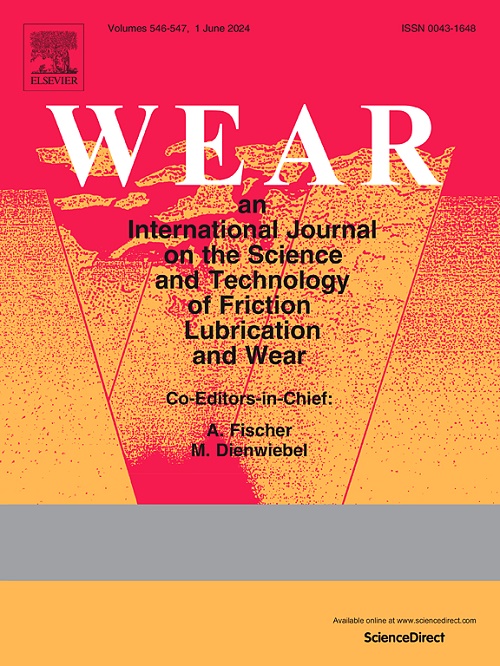Multistage dynamic damage and microstructural evolution of high-manganese steel under rolling-sliding contact conditions
IF 5.3
1区 工程技术
Q1 ENGINEERING, MECHANICAL
引用次数: 0
Abstract
Wear and fatigue are two critical challenges faced by railway frogs during service. However, existing studies have largely addressed these two damage mechanisms independently. In the present study, a twin-disc friction and wear test was employed to simulate the wear and rolling contact fatigue behavior of high-manganese steel used in railway frogs under service conditions. A detailed investigation was conducted to analyze the damage mechanisms and microstructural evolution of high-manganese steel over multiple test cycles. Results reveal that the damage evolution of high-manganese steel under rolling-sliding contact follows a dynamic and cyclic pattern. During this process, the surface-hardened layer undergoes repeated deformation strengthening, eventually leading to spalling and resulting in a distinct cyclic damage progression. This progression is primarily driven by the interplay between deformation strengthening, which enhances wear resistance, and the gradual accumulation of fatigue damage. As the surface-hardened layer spalls, the wear resistance deteriorates, exposing fresh layers to subsequent deformation strengthening and fatigue damage accumulation. This cyclical process culminates in the repeated occurrence of spalling damage. These findings offer valuable insights into the damage mechanisms of high-manganese steel under complex service conditions, providing a solid foundation for future research in this area.
滚动-滑动接触条件下高锰钢的多级动态损伤与显微组织演化
磨损和疲劳是铁路蛙类在使用过程中面临的两大关键挑战。然而,现有的研究在很大程度上是独立研究这两种损伤机制的。采用双盘摩擦磨损试验方法,模拟了高锰钢在使用工况下的磨损和滚动接触疲劳行为。对高锰钢在多次试验循环下的损伤机理和组织演变进行了详细的研究。结果表明:高锰钢在滚动滑动接触下的损伤演化遵循动态循环模式;在此过程中,表面硬化层经历反复变形强化,最终导致剥落,并导致明显的循环损伤进展。这种进展主要是由变形强化(增强耐磨性)和疲劳损伤的逐渐积累之间的相互作用所驱动的。当表面硬化层剥落时,耐磨性恶化,使新层暴露于随后的变形强化和疲劳损伤积累中。这种循环过程最终导致剥落损伤的反复发生。这些研究结果为高锰钢在复杂使用条件下的损伤机理提供了有价值的见解,为该领域的进一步研究奠定了坚实的基础。
本文章由计算机程序翻译,如有差异,请以英文原文为准。
求助全文
约1分钟内获得全文
求助全文
来源期刊

Wear
工程技术-材料科学:综合
CiteScore
8.80
自引率
8.00%
发文量
280
审稿时长
47 days
期刊介绍:
Wear journal is dedicated to the advancement of basic and applied knowledge concerning the nature of wear of materials. Broadly, topics of interest range from development of fundamental understanding of the mechanisms of wear to innovative solutions to practical engineering problems. Authors of experimental studies are expected to comment on the repeatability of the data, and whenever possible, conduct multiple measurements under similar testing conditions. Further, Wear embraces the highest standards of professional ethics, and the detection of matching content, either in written or graphical form, from other publications by the current authors or by others, may result in rejection.
 求助内容:
求助内容: 应助结果提醒方式:
应助结果提醒方式:


